Ansys博客
January 19, 2024
永磁闭锁:确保电子产品安全
永磁体材料,其磁场是由材料本身的内部结构产生。设计永磁闭锁机制的基本考量,就是确保磁体的设计可提供适当的闭锁力。两个永磁体之间的磁力由多个因素决定,例如两个磁体的间距、磁体的大小和永磁体本身的材料等。稀土磁体成本高昂,而Ansys Maxwell等低频率电磁场求解器可帮助工程师执行尺寸和材料研究,以便在降低磁性锁存器成本的同时,优化闭锁机制中的磁力。

图1:Ansys Maxwell中的材料与尺寸研究
使用永磁体的设备
手机、平板电脑、手表的无线充电器和智能屏幕盖,虚拟现实(VR)设备,磁性闭锁壁挂式安防摄像头,以及日常生活中无数的电子设备,都依靠永磁体提供磁力吸附机制。
对于某些应用(如安装安防摄像头),永磁体可替代螺钉和螺栓之类的机械紧固件。对于无线充电器等其它应用,磁体可确保接收器和发射器的准确对齐,从而可加速充电。在任何情况下,精心设计的电子产品磁性连接都能增强用户体验。
我们来回顾一下设计磁闭锁的一些重要注意事项。
磁性闭锁机制中的力
除永磁体外,软钢等铁磁材料的的存在也会影响磁性闭锁机制的力。考虑到将铁磁材料和永磁体结合使用所带来的变量,我们必须对铁磁分流器和磁通集中器进行建模,才能实现准确的力计算。
众所周知,铁磁钢在某些工作条件下会因强磁场而饱和。闭锁机制中的磁饱和是有害的,因为它不仅会限制磁力,而且还会导致杂散磁通,杂散磁通会与锁存器附近的霍尔传感器(其可检测磁场)相互作用。例如,在磁体装配体之间存在较大间距的情况下,软钢分流器可能不会饱和。然而,随着磁闭锁以及磁体与磁体之间的间距变小,软钢分流器可能会因较高的磁通密度而饱和。同样,软钢分流器的厚度也会影响饱和度。
Maxwell不仅可在采用铁磁钢的磁性闭锁器件中捕获磁饱和度,而且还可提供准确的磁场及力求解。
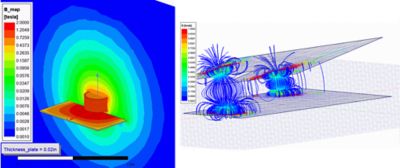
图2:铁磁材料饱和度(左)及杂散磁通可视化(右)
分辨率:收敛很关键
从有限元求解器获得准确磁场求解的关键要素是网格分辨率。应特别考虑网格单元的分布,以捕获间距和磁饱和效应。Maxwell会自动生成初始网格并自适应地对其进行细化,以达到用户定义的收敛标准,从而确保求解的准确性。
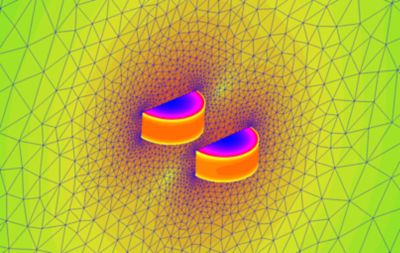
图3:自动自适应网格划分带来简单易行的精确求解
温度变化如何影响磁性锁存器?
设计磁性锁存器工程师面临的挑战之一是获得永磁体和铁磁钢的材料属性,如B-H曲线等。由于永磁体在不同温度下具有不同的材料属性,因此拥有足够材料库的访问权限,工程师不仅可进行材料扫描,而且还可研究温度对磁性锁存器性能的影响。Maxwell和Ansys Granta材料库为用户提供了访问多个永磁体厂商库的权限,其中包括不同温度下不同等级磁体的B-H曲线。
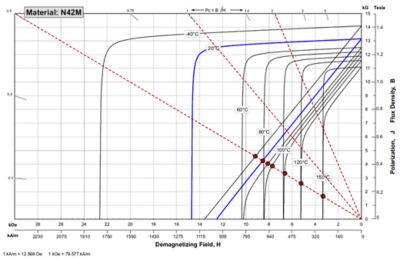
图4:N42M永磁体在不同温度下的消磁特征
永磁体退磁的避免和磁滞建模
永磁体对温度很敏感,在较高温度下容易退磁,退磁会导致磁性锁存器的力性能下降。永磁体在某些工作条件下的不可逆退磁会导致磁性锁存器机制失效。因此,工程师在设计磁性锁存器时必须考虑温度效应,这一点非常重要。图5是基于Maxwell一项研究的N42磁体在不同温度下的工作点(在空气中和放在磁路中时)。结果显示,温度越高,回复线出现的退磁越大。
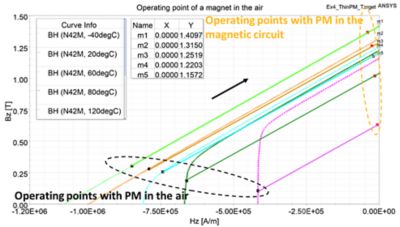
图5:工作点表示永磁体在较高温度下的退磁情况
除了退磁研究之外,还可使用Maxwell研究原磁体的磁化和铁磁材料中的磁滞效应等高级磁效应。在从附近移除永磁体时,铁磁材料的磁滞行为会在软钢中产生剩余磁通。剩余磁通可能会产生剩余力,在设计类似器件控制时需要考虑这一点。图6是在永磁体远离或靠近前一物体时,在标准1008碳钢物体中追踪到的矢量磁滞回路。
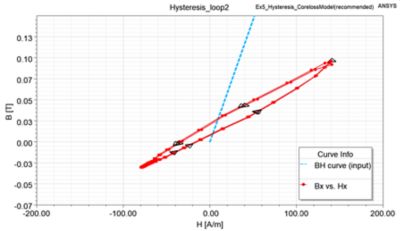
图6:带永磁体和铁磁钢的磁性锁存器(左);磁体越来越近及越来越远时,铁磁钢中的磁滞行为(右)
运行大量场景,以设计业界领先的磁性锁存器
执行气隙、材料、形状、尺寸和温度研究,需要大型实验设计(DOE)空间。高性能计算(HPC)和Ansys Cloud解决方案可帮助工程师并行运行不同设计,更快获得求解。
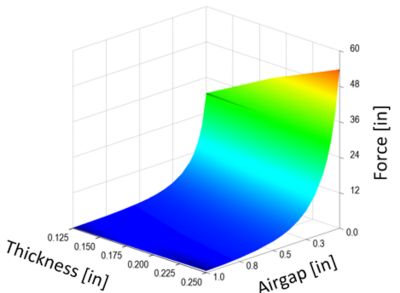
图7:Ansys Maxwell参数化研究的响应面
如上图所示,Maxwell可为磁性锁存器设计提供综合磁性求解,其中包括:
- 磁场和磁力求解
- 气隙、形状、尺寸和材料研究
- 饱和及杂散磁通效应
- 自动自适应网格划分带来简单易行的精确求解
- 面向DOE研究的HPC和云解决方案
- 磁化和消磁分析
- 矢量磁滞建模
了解磁性闭锁机制的结构动力学
除了设计磁性锁存器之外,仿真还有助于工程师通过耦合Maxwell与Ansys Motion来研究锁存和冲击应力过程中磁体的运动学运动。磁力、扭矩和位置信息可在Maxwell和Motion求解器之间交换,以计算闭锁机制的结构动力学。
以Maxwell为代表的Ansys综合磁性解决方案和多物理场解决方案,可帮助工程师设计稳健的磁性闭锁机制,这种机制高度可靠,还可增强用户体验,使用户可轻松将键盘、触控笔、耳塞、无线充电发射器等配件连接至平板电脑、手机或其它电子设备。
欢迎观看磁性闭锁点播网络研讨会,我们将探讨设计工程师如何通过在Ansys Maxwell中进行磁体尺寸和材料研究来实现成本节省,并提高磁性锁存器的性能。我们将介绍设计方面的关键内容,例如铁磁材料的饱和、高级磁性功能(包括磁化/退磁)、温度依存性、矢量磁滞建模以及复杂的运动学/冲击预测等。